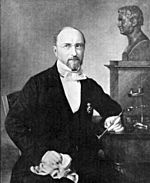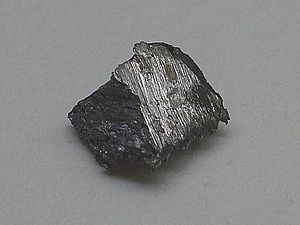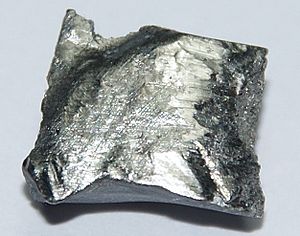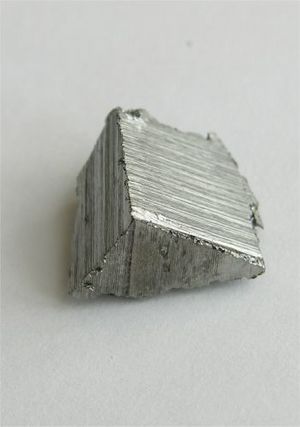Carl Gustaf Mosander facts for kids
Quick facts for kids
Carl Gustaf Mosander
|
|
|---|---|

Carl Gustaf Mosander
|
|
| Born | 10 September 1797 |
| Died | 15 October 1858 (aged 61) Lovö, Stockholm County
|
| Nationality | Swedish |
| Alma mater | Karolinska Institute |
| Known for | lanthanum erbium terbium |
| Scientific career | |
| Fields | chemistry |
| Institutions | Karolinska Institute |
Carl Gustaf Mosander (born September 10, 1797 – died October 15, 1858) was a Swedish chemist. He is famous for discovering three special elements called rare earth elements. These elements are lanthanum, erbium, and terbium.
Contents
Early Life and Learning
Carl Gustaf Mosander was born in a city called Kalmar in Sweden. He went to school there. In 1809, when he was 12, he moved to Stockholm with his mother.
In Stockholm, Carl started working as an apprentice at a pharmacy. An apprentice is someone who learns a skill by working with an expert. He passed his pharmacy test in 1817. But he was also very interested in medicine. So, in 1820, he joined the Karolinska Institute, which is a famous medical university. He finished his medical studies in 1825.
Carl also worked in the lab of a very important chemist named Jöns Jacob Berzelius. He became good friends with another student there, Friedrich Wöhler.
His Work as a Chemist
In 1832, Carl Gustaf Mosander took over from his teacher, Jöns Jakob Berzelius. He became a professor of chemistry and pharmacy at the Karolinska Institute.
From 1845, Mosander also taught at the Pharmaceutical Institute. He helped manage the rock and mineral collections at the Swedish Museum of Natural History. This museum was started by the Royal Swedish Academy of Sciences in 1819. Carl also owned a spa in Stockholm where people could drink special mineral waters.
Discovering Lanthanum
In 1838, Mosander discovered lanthanum. He found it in a mineral called Cerite-(Ce) from Sweden. At that time, people thought this mineral only contained an element called "Cerium."
Mosander found that "ceria," which was thought to be a pure substance, was actually a mix. He heated it and treated it with a weak acid called nitric acid. This process helped him separate a new element.
He was a bit nervous to share his discovery. He worried it might make his mentor, Berzelius, look bad. Berzelius had discovered cerium. Mosander also wasn't sure if he had found all the parts of cerium. Berzelius later suggested naming the new element "lanthan." This name means "hidden," because it was hidden inside cerium.
The Story of Didymium
By 1840, Mosander had separated cerium oxide into three parts. There was yellow cerium oxide, white lanthanum oxide, and a third pinkish part. He called this new part "didymium," which means "twin."
For many years, didymium was thought to be a single element. It even appeared on Dmitri Mendeleev's periodic table. But in 1874, another scientist, Per Teodor Cleve, thought didymium might be made of at least two elements.
Later, in 1879, Lecoq de Boisbaudran found a new element called samarium from didymium. Then, in 1885, Carl Auer von Welsbach finally separated didymium into two more elements. He used a method called fractional crystallization. Welsbach named them praseodidymium (green didymium) and neodidymium (new didymium). Today, we know them as praseodymium and neodymium.
Finding Terbium and Erbium
In 1843, Mosander discovered two more elements: terbium and erbium. He found these elements inside another substance called yttria.
However, other scientists debated this discovery. A scientist named Nils Johan Berlin did not believe that two new elements existed. He thought "erbia" was not real.
In 1864, Marc Delafontaine used a special method called optical spectroscopy. This method proved that yttrium, terbium, and erbium were indeed separate elements. But there was a mix-up with the names! Mosander's original names for the compounds were switched. So, the purple substance became "erbium" oxide, and the yellow substance became "terbium" oxide.
Mosander became a member of the Royal Swedish Academy of Sciences in 1833. This is a great honor for scientists in Sweden.
Personal Life and Later Years
Carl Mosander married Hulda Philippina Forsström on December 20, 1832. They had four children, including two sets of twins.
Later in his life, Mosander had problems with his eyes because of cataracts. He died in 1858 at his summer home. This home was on an island called Lovön in Stockholm County.
See also
 In Spanish: Carl Gustaf Mosander para niños
In Spanish: Carl Gustaf Mosander para niños





